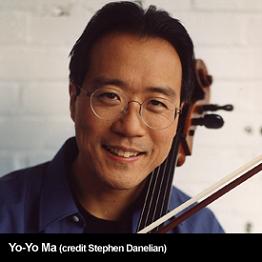Review: Yo-Yo Ma's Recital At Symphony Center
By Alexander Hough in Arts & Entertainment on Mar 25, 2010 8:40PM
 Yo-Yo Ma is the most famous living classical musician. That can't actually be proven, of course, but outside of fussy opera devotees or a stray Itzhak Perlman groupie, no one will argue it. When he was seven, Ma's talent brought him to the Kennedy White House. He firmly entered the classical world's awareness in his teens, and his many cross-genre collaborations have taken him into other music worlds. He's a United Nations Messenger of Peace and a member of the President's Committee on the Arts and the Humanities. Even if you're not a classical music fan, you know about him, if only because you heard his name as a punchline on "Seinfeld," saw his cartoon visage shooting cello bows at Homer Simpson, or watched him (sort of) perform at Obama's inauguration. He's talented, articulate, and, by all accounts, one of the nicest, most genuine famous people you'll ever care to meet.
Yo-Yo Ma is the most famous living classical musician. That can't actually be proven, of course, but outside of fussy opera devotees or a stray Itzhak Perlman groupie, no one will argue it. When he was seven, Ma's talent brought him to the Kennedy White House. He firmly entered the classical world's awareness in his teens, and his many cross-genre collaborations have taken him into other music worlds. He's a United Nations Messenger of Peace and a member of the President's Committee on the Arts and the Humanities. Even if you're not a classical music fan, you know about him, if only because you heard his name as a punchline on "Seinfeld," saw his cartoon visage shooting cello bows at Homer Simpson, or watched him (sort of) perform at Obama's inauguration. He's talented, articulate, and, by all accounts, one of the nicest, most genuine famous people you'll ever care to meet.
One downside of this renown is that it makes seeing Ma perform live extremely difficult. Tickets to his recital at Symphony Center last night were prohibitively expensive - a main floor ticket was at least $94, and the cheapest seat, way up in the gallery, was still $65.
That's a shame because those who were willing and able to shell out the entrance fee were treated to a stunning show. The lengthy program was a varied mix, consisting of 19th-century works (Franz Schubert's "Arpeggione" Sonata in A Minor and César Franck's Violin Sonata in A Major arranged for cello by Jules Delsart); a 20th-century classic (Dmitri Shostakovich's Sonata in D Minor); and a pair of modern works by South American composers (Astor Piazzolla's "Le Grand Tango" and Egberto Gismonti and Geraldo Carneiro's "Bodas de Prata and Quatro Cantos"). A recital features a single player, although most instruments' solo repertoire, particularly that of strings, also has piano accompaniment, and pianist Kathryn Stott performed on all the night's selections. The highly collaborative program felt more like a duet than a Ma exhibition, due to terrific balance between the two musicians and sensitivity to each other's playing, which actually seemed more present on Ma's side. If the man has an ego, he keeps it private.
We were a little worried about the acoustics of a recital being held in Orchestra Hall, a room built for - wait for it - orchestras, but the Chicago Symphony Orchestra's home is fairly accommodating to small, unamplified acts, and Ma's warm sound did a surprisingly good job filling the space. The tone reached its peak when Ma and Stott played softly together, a sound I wish could be made into a mattress cover (if you prefer a different metaphor, my lovely companion likened Ma and Stott's sound to eating a marshmallow).
Ma's technique was effortlessly brilliant, although the pieces chosen weren't showcases of virtuosity. The duo took the interpretive middle ground, occasionally drifting towards romantic rubato. Most striking was the crafting of musical phrases. The lines blossomed and ended seemingly as thought-free as breathing, but it was the treatment of the spaces between phrases, movements, and pieces that stood out. We're not drifting into the realm of abstract nonsense (the jazz saying about the importance of the notes you don't play comes to mind); rather, the space between phrases affects how those two phrases, taken together, sound. A piece of music is composed of these phrases (and phrases of phrases, and so on) so that, in the same way, the space in between movements and pieces is important, too. Ma and Stott managed these pauses perfectly - to the point where the audience remained rapt and didn't use the breaks as the usual coughing/shifting-in-seats time (which unfortunately led to the beginning of many a movement being obscured by the expectoration of a crowd unusually rife with respiratory issues). It's a skill that is often overlooked, but, as Ma and Stott proved, one that adds much to a performance.
We struggle a bit with whether to recommend seeing Ma play. If external factors - cost and ticket availability - aren't an issue, yes, by all means, go. But there are many very talented cellists who command a lower ticket price. If you do take the plunge, you can count on two things. First, Ma will do what he can to give you your money's worth - last night's concert included two encores, Cesar Camargo Mariano's "Cristal" and Camille Saint-Saëns's "The Swan" from "Carnival of the Animals" and didn't wrap up until close to 10:30 p.m. Second, many opportunities to see him will present themselves. Ma was already a frequent performer at Symphony Center and Ravinia, and he'll be in town even more now that he's the CSO's creative consultant, a position that will have him developing chamber music programs and working with the outreach programs of the CSO's Institute for Learning, Access, and Training. His next scheduled Chicago performance will be in May, when he joins the CSO to premiere a cello concerto by Dmitri Yanov-Yanovsky.